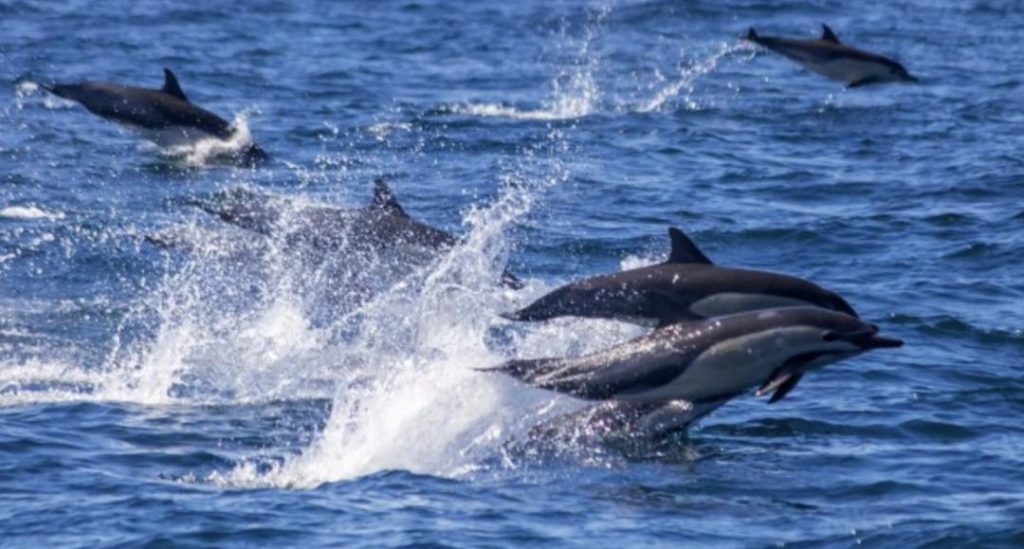
Dolphins & Whales Regularly Socialise with Each Other: Study
In a fascinating discovery, researchers from Griffith University have found that dolphins and whales are more than just acquaintances – they are social buddies! A recent study published in the journal Marine Mammal Science has revealed that these marine mammals regularly interact with each other in playful and mutual socializing.
The study, which analyzed videos and photographs of interactions between baleen whales and dolphins, covered 19 species across 199 separate events. The findings suggest that dolphins and whales frequently socialize, with playfulness being a common theme in their interactions.
One of the most common interactions observed was dolphins swimming near the head of a whale. This behavior was seen in several species of dolphins, including the bottlenose dolphin, which was the most involved dolphin species in the study.
Researchers believe that these playful interactions may serve several purposes, including social bonding, learning, and even communication. “These findings demonstrate that dolphins and whales are capable of complex social interactions, and that they are not just solitary animals,” said Dr. Ellen Garland, a researcher at Griffith University and lead author of the study.
The study’s findings are significant not only because they reveal a previously unknown aspect of dolphin and whale behavior but also because they underscore the importance of social interaction in the natural world. In an era where human social skills are being eroded by increasing reliance on technology, the study’s results serve as a reminder of the importance of social bonding in all forms of life.
So, what exactly did the researchers find? Let’s dive into the details.
The Study’s Findings
The study, which was conducted over a period of three years, involved analyzing videos and photographs of interactions between baleen whales and dolphins. The researchers focused on 19 species of dolphins and 10 species of whales, including humpback, blue, and gray whales.
The study’s findings can be summarized as follows:
- Dolphins and whales interact frequently: The study found that dolphins and whales interacted with each other in 199 separate events, with some interactions occurring multiple times.
- Playfulness is a common theme: Playful behavior was observed in many of the interactions, with dolphins and whales engaging in activities such as swimming together, breaching (jumping out of the water), and even playing with seaweed.
- Dolphins swim near the whale’s head: One of the most common interactions observed was dolphins swimming near the head of a whale. This behavior was seen in several species of dolphins, including the bottlenose dolphin.
- Bottlenose dolphins are the most involved: Bottlenose dolphins were the most involved dolphin species in the study, with 44% of the interactions involving this species.
What Does it Mean?
The study’s findings have significant implications for our understanding of dolphin and whale behavior. For one, they suggest that these marine mammals are capable of complex social interactions, which challenges the traditional view of them as solitary animals.
The study also highlights the importance of social bonding in the natural world. Social interactions are essential for building relationships, resolving conflicts, and even learning new skills. In the case of dolphins and whales, socializing may serve multiple purposes, including communication, learning, and even cooperation.
Furthermore, the study’s findings have implications for conservation efforts. As we work to protect these magnificent creatures and their habitats, it is essential that we consider the importance of social interaction in shaping their behavior and well-being.
Conclusion
The study’s findings are a testament to the complexity and beauty of dolphin and whale behavior. As we continue to learn more about these incredible animals, we are reminded of the importance of social interaction in the natural world.
As we look to the future, it is essential that we prioritize conservation efforts that take into account the social needs of these animals. By doing so, we can work to protect not just individual species but entire ecosystems.
In the meantime, let us marvel at the playful interactions between dolphins and whales, and let us continue to learn from these incredible creatures.
Source:






